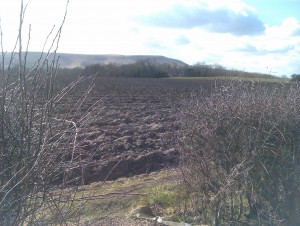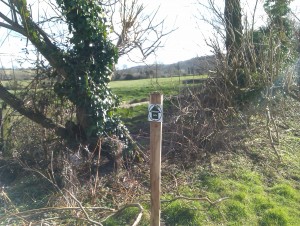Support us from £3/month
We deal with almost 1000 cases a year assisting communities, groups and individuals in protecting their local spaces and paths in all parts of England and Wales. Can you help us by joining as a member?
But you will need your wellies on!
Open Spaces Society member Chris Smith has created a walk highlighting the secret multi-million pound footpaths of Firle. You can find it on-line here.

The path departs from the point at the bottom of the picture and the route is ploughed up as shown. The photo is taken slightly to the right of the line of the path.
The Firle Estate, near Lewes in East Sussex, contains some of the most iconic walking landscape in the country, including the Firle Beacon stretch of the South Downs Way. There are many legal rights of way and areas of statutory public access, but, as many landlowners will ruefully tell you, you don’t get money for that. So it might surprise you to learn that the Estate has obtained exemption from inheritance tax (1) on nearly all the estate which would otherwise be subject to inheritance tax (2) in return for keeping the estate in good condition and allowing public access.
This is a considerable tax concession and one that many home owners in the South-East would like to have.
But what are we getting for our money?
An examination of the agreements made between the estate and the government show that all we seem to have got are two short footpaths:
1) South from Charleston Farmhouse to meet the old coach road.
2) South from the car park at the Barley Mow Inn at Selmeston, to join the lane about 375 metres to the south.
In addition Firle House, with associated artworks, is open to the public on a limited number of days of the year – but you have to pay a substantial charge for this.
And that’s just about it! There is no requirement to provide access to woodland or parkland, for example.
There are other conditions that the estate must comply with, but these are largely things that they have a statutory duty to do, such as keeping rights of way open, or which would be required by planning laws or which any good manager would do (3).
The new walk
Chris set out to publish a walk guide so that members of the public could use these paths. Things started to go wrong when he got to the path at the Barley Mow and found that it was completely ploughed up! He was able to walk round the edge of the field to walk along a parallel legal right of way 30 metres to the east.
He says “To get tax breaks for creating a footpath when there is a parallel one just 30 metres away is cheeky, but to plough it up is just downright rude.”
Having navigated this obstacle Chris was pleased to see that the other path, from Charleston Farmhouse, had now been signposted.
He comments- “For many years these paths were not signposted at all so few people knew about them. After the Open Spaces Society publicised what was going on some signs were erected. Now I hope that, with this guide, ordinary people will be able to get something in return for this tax giveaway”.
For further information contact Chris Smith, OSS Brighton and Lewes correspondent on 01273 483869 or cs@hbhelp.co.uk
Notes:
1 Inheritance tax is normally charged at 40% of the value of any estate over £325,000. Agricultural land being worked is normally exempt, but buildings, parkland and woodland are normally subject to tax.
2 The exemption includes Tilton Farm (former home of Maynard Keynes) and Firle Place itself, although not the main building at Charleston (home of the Bloomsburys) which is now owned by the National Trust. Agricultural land is not subject to inheritance tax, so the exemption only applies to buildings, parkland and woodland.
3 For example, the managers must undertake “Preservation of woodlands to maintain their amenity, flora and fauna and sporting value” (but there is no public access to these “amenities”

